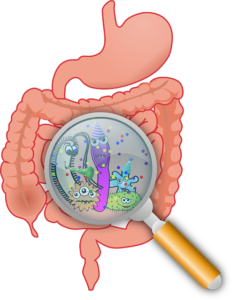The roles gut microbes play in health, disease and strategies
Microorganisms are fascinating components in life on earth. Many functions that used to be attributed to bigger life forms or their organs, are actually performed by microorganisms that have adjusted to a specialized niche, and effectively have become part of that life form.
 When we observe the water-cleansing properties of a natural or constructed wetland, the filtration happens in the root system of the plants, while the processing of the filtrated substances is done by the microbes attached to the fine roots, and supplying them with nutrients. We talk of symbiosis, but it really is an integrated part of the plant’s organism. This is easier to understand when we perceive even individual beings as ecosystems – intelligent collaborations with buffering systems and multiple methods of self-organization.
When we observe the water-cleansing properties of a natural or constructed wetland, the filtration happens in the root system of the plants, while the processing of the filtrated substances is done by the microbes attached to the fine roots, and supplying them with nutrients. We talk of symbiosis, but it really is an integrated part of the plant’s organism. This is easier to understand when we perceive even individual beings as ecosystems – intelligent collaborations with buffering systems and multiple methods of self-organization.
You and me are ecosystems
Apart from all the singular cells belonging to our body e. g. in our blood, even our organs consist of merged cell communities which create specialized microclimates in accord with the required function.
Stem cells prove the capability of diversification inside the organism. The functions of our living bodies enclose our microbes which exceed the number of the “true” body cells by a centuple: in and on each of us live 2000 different kinds of bacteria, that represent 1-3% of our body weight. These kinds are functional and both ethnically and environmentally specific – this is why we can draw conclusions about the migration of peoples by microbial analyses. [1]
Ethnically or individually – research has proved a connection between our microbiome and our mood and behaviour:
Studies with mice illustrate how the population with specific strains of microbes in the gut, compared to their absence, leads to behavioural changes.
Normally, mice show a certain caution and preference of protected spaces for dwelling. In the experiment, they were put into a maze with partly closed, partly open alleys. Expectedly, the control group of untreated mice with their typical gut microbes avoided the open alleys. A group of germ-free mice however showed much less caution and explored the maze fearlessly! [2] [3] [4]
In another study, the gut conditions of both groups were exchanged, which directly affected their behaviour. This proves that behavioural characteristics of different groups of mice are directly related to their gut microbiome. [5]
Can we really go on seeing ourselves and our personality isolated from our germs?
Our microbes – Helpers through thick and thin?
 In META-Health we are aware of how comprehensively body, mind and environment are correlating. Microorganisms play a role in the processing of conflicts and traumatic experiences – not only on a physical level, but for our overall being. Microbes take part in adapting tissues to new demands, namely in helping them proliferate, or to degrade them. Many of these processes are conventionally seen as pathological. However there is internal regulation, and intervention is only needed when the process escalates under unfavourable conditions. Let’s explore what I mean by that:
In META-Health we are aware of how comprehensively body, mind and environment are correlating. Microorganisms play a role in the processing of conflicts and traumatic experiences – not only on a physical level, but for our overall being. Microbes take part in adapting tissues to new demands, namely in helping them proliferate, or to degrade them. Many of these processes are conventionally seen as pathological. However there is internal regulation, and intervention is only needed when the process escalates under unfavourable conditions. Let’s explore what I mean by that:
The intelligent organism controls the activity of it’s microbes by dynamically adjusting the internal environment, and by the lymphatic system. It can thereby make different kinds of microbes limit each others’ populations. The psycho-biological perception and evaluation of stressors, toxins and resources is leading the individual to “catch”, tolerate, or resist the germs present in the environment, according to the biological requirements and resilience.
For example, in case that excess tissue has been built up as reinforcement during a time of stress, bacteria and fungi can help decomposing that excess after conditions have changed, and leukocytes will control and clear them.
Ever more of these intelligent interrelations are being recognized in scientific studies. Lactobacteria (Lactobacillus reuteri) for example are promoting wound-healing via a raise of oxytocin levels, according to Theofilos Poutahidis et al [6] Oxytocin is a neuropeptid hormone related to social behaviour and reproduction, that is mediated via the vagus nerve.
In another study by Theofilos Poutahidis et al [7], ingestion of Lactobacillus reuteri led to enhanced fertility by increased sperm production, testicle size, and number of Leydig cells (the main site of testosterone production). Typical ageing processes connected to testosterone reduction and inflammatory reactions, were stopped and reversed through supply with Lactobacillus reuteri. [7]
Probiotics, our microbial profile and programming
 The dissertation of Gabriela Sinkiewicz from Malmö University “Lactobacillus Reuteri in Health and Disease” [8] investigates the natural presence of these bacteria in human breast milk, saliva, and gut, as well as it’s influence on our health. As expected, this microbe is not naturally present in all humans: it is found in 15% of the population, more often in country- than in city dwellers. This may be due to long-termed nutritional habits. While regular intake of Lactobacillus Reuteri in the study showed positive effects on (present) gingivitis, a long-termed change in mouth and gut microbiome of the subjected group was not detected. [8]
The dissertation of Gabriela Sinkiewicz from Malmö University “Lactobacillus Reuteri in Health and Disease” [8] investigates the natural presence of these bacteria in human breast milk, saliva, and gut, as well as it’s influence on our health. As expected, this microbe is not naturally present in all humans: it is found in 15% of the population, more often in country- than in city dwellers. This may be due to long-termed nutritional habits. While regular intake of Lactobacillus Reuteri in the study showed positive effects on (present) gingivitis, a long-termed change in mouth and gut microbiome of the subjected group was not detected. [8]
Obviously, assimilation of the respective bacteria depends on their presence in the subjects’ environment, as well as on his receptiveness! The latter depends on factors of familiarity and accustoming (aka eating habits), and on above discussed needs regarding autonomous processes of self-maintenance.
CFS, microbes and anxiety
Studies showed that the gut microbes of CFS patients usually are low in bifido bacteria, and that this condition could actually be regenerated after intake of colony-building lacto- and bifidobacteria over 2 month. Simultaneously, anxiety reactions decreased significantly during that time. [9]
These findings indicate that in CFS and anxiety reaction patterns, the body seems to be receptive for named bacteria as far as they are offered.
These are typical symptoms of which minimum 4 must be present in a CFS diagnosis:
- Restricted short-term memory or focusing skills
- Sore throat
- Sensitive cervical and axillary lymph nodes
- Muscle aches
- Pain without inflammatory signs in multiple joints
- Headache of a new type or severity
- No sufficient recovery by sleep
- Worsening of the condition for more that 24 hours after efforts
These symptoms seem without exception to be parts of impaired and prolonged regeneration phases. Regeneration asks for high-quality nutrients to be broken down by the gut bacteria. Therefore, the organism in question is receptive for appropriate bacteria when they are accessible. As a novel intervention, even fecal transplants become popular in the therapy of both bowel disease and anxiety.[10]
The association of CFS with anxiety may be a key to the repeating pattern: one possible scenario could be recurring self-devaluation e. g. inside the job environment, which affect joints and muscles. In daily life these are resolved or compensated, but fear about losing the job, or stress in the family environment do not allow the subject to regenerate properly.
These patterns may probably be improved by an optimized diet that includes lacto- and bifidobacteria..
Meaningful strategies in MS?
On the other hand, scientists were astonished that a healthy gut microbiome seems to contribute to diseases like multiple sclerosis [11]. The META-Health perspective that disease as well as microbial activity generally play roles in biologically meaningful processes controlled by the body itself, offers an explanation: so called autoimmune diseases are recurring conflict patterns that include strategies to warn and protect the individual against potential threats.
The programming of the brain (and genetic change accordingly) prompts this strategy and uses the functional equipment – the microbiome – to mediate the signals. The resolution for concerned persons would here be re-programming on brain level – as we do by hypnotic techniques or root-cause transformations as regression and re-imprinting – thereby enhancing resilience.
Communication of mind, brain and organ
How and when does the population with our specific microbial fingerprint take place, and what implications does this have for our internal resources and resilience? Investigation of melolontha (may bug) guts in (sterile) larvae and the adult state indicate, that part of the microbiome is present already in the early state [12].
Remaining population happens mainly during and after birth [13]. The Central Nervous System and the neuroendocrine system develop simultaneously with the microbiome, and they are sensitive to distress [14]. The vagus nerve has been identified as communication path of the gut-brain axis in both ways [15]. These findings confirm the relationship of imprinting experiences, microbes and organ functioning that we refer to in META-Health, based on that the Autonomic Nervous System is mediating between these.
Distressful experiences and conflict patterns of the mother during pregnancy and birth influence this relationship, as do early childhood experiences and long-termed social environment. They create a background of resilience or sensitivity for conflicts later in life.
By appropriate and wanted intervention spanning nutritional, psychological and neuro-endocrino-immunological levels, these imprinted patterns can be corrected and completed, thereby equipping the subject for better health.
Summary
Emotional and behavioural patterns, as well as resilience, are related to our individual microbiome. The basic equipment is provided prenatally by the mother’s body, after birth it is added to by breast milk and primary contact to the environment during the imprinting stage of brain, nervous system and gut function. At later stages, habit change over longer time periods is required to naturally change this part of our personality. Consequent intake of probiotics can be used purposefully to support gut functioning and to reduce stress and anxiety reactions via the gut-vagus-brain axis, together with interventions targeting imprinted trauma.
Study the methodology of health!
First published on META-Evolution Blog
sources:
[1] http://www.scinexx.de/dossier-563-1.html
[2] http://www.sciencedirect.com/science/article/pii/S001650851100607X
[3] http://onlinelibrary.wiley.com/doi/10.1111/j.1365-2982.2010.01620.x/full
[4] http://www.chirurgie-portal.de/news/20121112-darmbakterien-einfluss-gehirnfunktion.html
[5] http://www.sciencedirect.com/science/article/pii/S001650851100607X
[6] http://www.ncbi.nlm.nih.gov/pmc/articles/PMC3813596/
[7] http://www.ncbi.nlm.nih.gov/pmc/articles/PMC3879365/
[8] http://dspace.mah.se/bitstream/handle/2043/10570/GS_dissertation.pdf?sequence=2
[9] http://www.ncbi.nlm.nih.gov/pmc/articles/PMC2664325/
[10] https://www.ncbi.nlm.nih.gov/pmc/articles/PMC4977816/
[11] http://www.mpg.de/4613890/darmbakterien_loesen_multiple_sklerose_aus
[12] http://www.ice.mpg.de/ext/fileadmin/extranet/common/documents/PULS-CE/Newsletter21_de.pdf
[13] http://www.nature.com/nrgastro/journal/v9/n10/full/nrgastro.2012.165.html
[14] http://onlinelibrary.wiley.com/doi/10.1113/jphysiol.2004.063388/full
[15] http://www.ncbi.nlm.nih.gov/pmc/articles/PMC3179073/
pictures:
Kora Klapp, Jens Buurgaard Nielsen, Janice Carr
 META-Healthy Life articles are created by professionals and friends of META-Health International CIC, supporting individual and global health by deepening and sharing our understanding of how resilience and well-being are achieved.
META-Healthy Life articles are created by professionals and friends of META-Health International CIC, supporting individual and global health by deepening and sharing our understanding of how resilience and well-being are achieved.